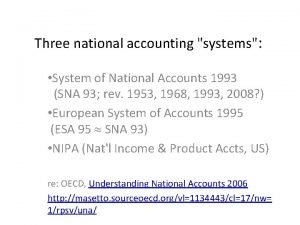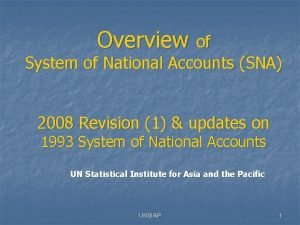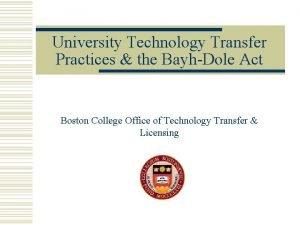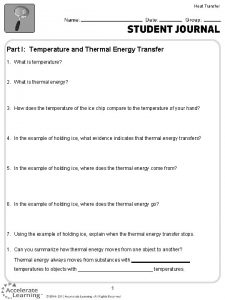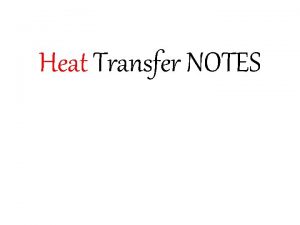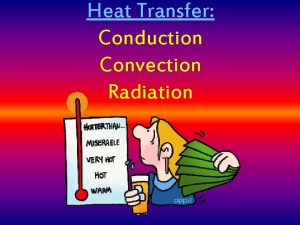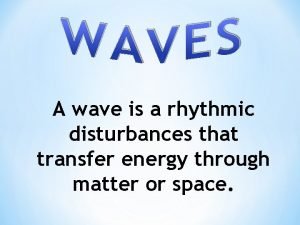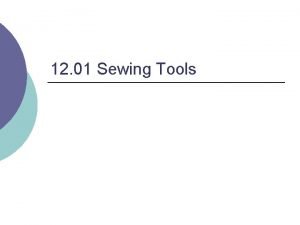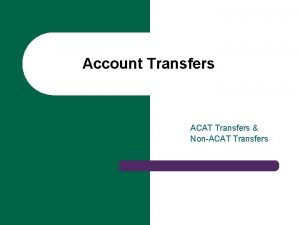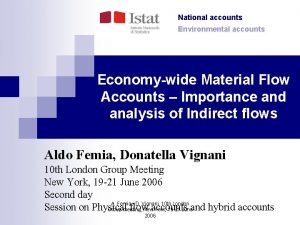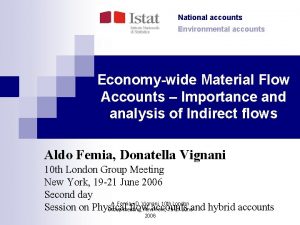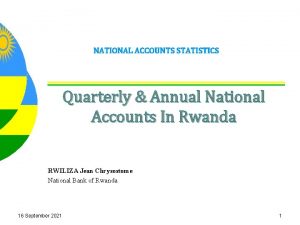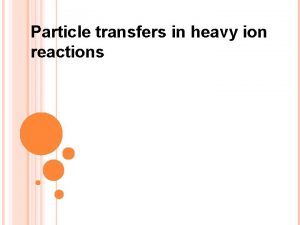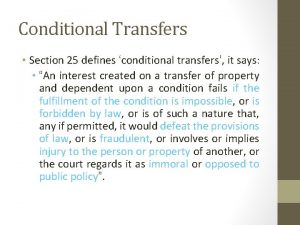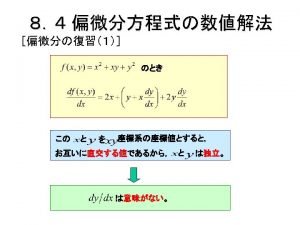National Transfer Accounts Private Transfers Marjorie Pajaron University








































- Slides: 40

National Transfer Accounts: Private Transfers Marjorie Pajaron University of Hawaii at Manoa & East-West Center National Transfer Accounts 1

The Flow Account Identity National Transfer Accounts 2

A Classification of NTA Reallocations. Asset-based Age Reallocations Capital and Other Non-Financial Assets Public infrastructure Public land subsoil minerals Private Housing Consumer durables Factories, Farms Private land subsoil minerals Inventories Credit Transfers Public debt Student loans Money Public education Public health care Unfunded pension plans Consumer credit Familial support of children and parents Bequests Charitable contributions Source: Mason, Lee et al. (forthcoming); adapted from Lee (1994). National Transfer Accounts 3

NT Flow Account, Aggregate. Taiwan, 1998 (NT$ billion), nominal Age Total 0 -19 20 -29 30 -49 50 -64 65+ Reallocations 832 1, 704 7 -1, 329 25 424 Asset-based reallocations 861 -5 -26 499 181 213 Income on Assets 2, 456 4 175 1, 539 528 211 Less: Saving 1, 595 9 201 1, 040 347 -2 Transfers -29 1, 710 33 -1, 828 -155 211 Public 2 611 51 -673 -103 116 -31 1, 099 -18 -1, 155 -52 95 Private Note. Some columns do not total because of rounding. Net transfers consist of public transfers (cash transfers + in-kind transfers less taxes) and private transfers (mostly familial transfers). Positive values imply that inflows exceed outflows. National Transfer Accounts 4

Outline Private Transfers II. Inter-household Transfers III. Intra-household Transfers IV. Summary I. National Transfer Accounts 5

I. Private Transfers National Transfer Accounts 6

I. Private Transfers ► Members of one age group provide economic resources to members of another age group, which is mediated by the households and nonprofit institutions serving household sector (NPISH) ► Motives for private transfers are not determined ► “Flows that involve no explicit quid pro quo. ” ► “Private transfers must balance, i. e. , inflows = outflows in total. ” National Transfer Accounts 7

I. Private Transfers ► Private transfer function: individuals give and receive transfers § Inter-household transfers § Intra-household transfers § Capital transfers, e. g. , bequest, dowries, etc. National Transfer Accounts 8

I. Private Transfers National Transfer Accounts 9

II. Inter-household Transfers National Transfer Accounts 10

II. Inter-household Transfers ► Transfer of resources to and from other households, NPISH and ROW ► Held by the household head ► Steps for constructing age profile: 1) Use household survey data and make sure there is only one household head; 2) For inflows, look for variable that measures the transfers from other household, individuals, and NPISH * (e. g. remittances received from other households, charities from church, etc. ) National Transfer Accounts 11

II. Inter-household Transfers ► Steps for constructing age profile: 3. For outflows, look for variable that measures the transfers to other household, individuals, and NPISH * (e. g. donations to churches, charities, etc. ) 4. Tabulate these variables by age of head making sure that you use weights 5. Smooth the age profile 6. Adjust the age profiles to match the macro control * National Transfer Accounts 12

II. Inter-household Transfers ► Inflows = Outflows if there are no inflows from or outflows to other countries. ► Private Transfer macro control is attributed to net inter-household transfers since intrahousehold transfer must net to zero. ► Remittances are considered as interhousehold transfers (true for Mexico and partially for the Philippines). National Transfer Accounts 13

II. Inter-household Transfers 3 Methods in Adjusting Inter-HH Inflows and Outflows if total inflows are not equal to total outflows 1. One multiplicative adjustment factor for inflows & outflows 2. One multiplicative adjustment factor for inflows & one for outflows 3. Adjusting either inflows or outflows, but not both National Transfer Accounts 14

II. Inter-household Transfers References: (1) Additional notes for private transfer methodology: http: //www. schemearts. com/proj/nta/web/nta/repository /Private_Transfer_Notes (2) Taiwan STATA code: <See Share drive> National Transfer Accounts 15

II. Inter-household Transfers National Transfer Accounts 16

II. Inter-household Transfers National Transfer Accounts 17

III. Intra-household Transfers National Transfer Accounts 18

III. Intra-household Transfers ► Indirectly measured by comparing estimates of the consumption of each individual with the income of each individual. ► Transfers for current consumption – when members incur current deficits (disposable Y < current C) they receive transfer inflows from members who have current surplus (disposable Y > current C). ► Inflows and outflows depend on surpluses and deficits of each member not on individual characteristics such as age. National Transfer Accounts 19

III. Intra-household Transfers ► Disposable income (YD) YD = Labor Income + Public Cash Transfer Inflows – Taxes Paid (Including Indirect Tax on Consumption) + Net inter-household transfers + Public Asset Income – Public Saving (in green font, to be verified) National Transfer Accounts 20

III. Intra-household Transfers ► Methodology in estimating the age profile of intra-household transfers § Preparation of Data § Transfers for Current Consumption § Transfers of Remaining Surplus to Head § Transfers for Durable Consumption ► Graphical Illustrations ► Example of intra-household transfers age profiles National Transfer Accounts 21

III. 1 Preparation of Data 1. Using the household survey, the following unsmoothed variables adjusted to control totals should be available (assuming a single survey has all the necessary variables): (a) labor income (b) current consumption sectors – education, health, other (c) durable consumption sectors – housing, other (d) public cash transfers (e) public asset income (to be verified) (f) public saving (to be verified) (g) taxes paid (including indirect tax on consumption)* (h) inter-household transfers National Transfer Accounts 22

III. 1 Preparation of Data 1. Unsmoothed variables adjusted to control totals (single survey used) 2. What to do if variables come from two (or more) survey problem (? ) a) Choose one survey that has household head and age of all members b) Assign control total-adjusted profile values (from other surveys) to each individual based on age c) Apply intra-household transfer methodology using the assigned profile instead of survey responses. 3. Only one household head per household 4. Consumption values must be non-negative National Transfer Accounts 23

III. 2 Transfers for Current Consumption 1. Compute for surplus/deficit for each member i in household j and total surplus/deficit for household j (*) Surplus (i, j) if (Disposable Y (i, j) - Total Current C(i, j)) > 0 Deficit (i, j) if (Disposable Y(i, j) - Total Current C(i, j)) < 0 2. Compute for total surplus/deficit for household j Shortfall exists for household (j) if the total deficit in household (j) > total surplus in household (j) National Transfer Accounts 24

III. 2 Transfers for Current Consumption 3. Calculate the tax rate § § Tax rate varies across households but is independent of the age of the individual within the household. Flat-rate tax is imposed on each member’s surplus income and this taxed surplus is transferred to support current consumption of other members. (*) Tax (j) = min (1, Deficit (j) / Surplus (j) ) Deficit (j) = total deficits of all household members in household j Surplus (j) = total surpluses of all household members in household j National Transfer Accounts 25

III. 2 Transfers for Current Consumption 4. Compute for intra-household outflows for current consumption § § Non-heads transfer resources to other members equal to their taxed surplus Heads transfer resources to household members equal to their taxed surplus and any shortfall that he/she finances through asset income or dis-saving, excluding his/her own deficit (*) (show numerical example) Heads Non-heads Outflows = Tax(j) * Surplus of head + Shortfall (j) - Deficit of non-head National Transfer Accounts 26

III. 2 Transfers for Current Consumption 5. Compute for intra-household inflows and outflows for current consumption by sector. § § Transfers received by non-head in each current consumption sector is equal to the proportion of that sector to his total current consumption. Household head has the same calculation except that he/she has to finance his/her own deficit through asset income or dis-saving, which is not recorded as transfer (when shortfall exists for the household). (*) Heads Non-heads * true for all sectors Inflows Education = (Education (i)/Total Current Consumption (i)) * max [0, Deficit of head – * Deficit of non-heads Shortfall of household] National Transfer Accounts 27

III. 2 Transfers for Current Consumption ► Current transfer outflows from individual (i) in each current consumption sector are proportional to the total household inflows to each sector. Heads Non-heads * true for all sectors Outflows Education = (Education (j)/Total Current Consumption Inflows (j)) * Total Outflows (i) National Transfer Accounts Outflows Education = (Education (j)/Total Current Consumption Inflows (j)) * Total Outflows (i) 28

III. 2 Transfers for Current Consumption ► To verify if the calculations are correct: total inflows = total outflows (for each sector, by household, and in aggregate) * National Transfer Accounts 29

II. Intra-household Transfers References: (1) Private Transfers document in NTA website: http: //www. schemearts. com/proj/nta/web/nta/show/Doc uments/Private%20 Transfers (2) Additional notes for private transfer methodology: http: //www. schemearts. com/proj/nta/web/nta/repository /Private_Transfer_Notes (3) Taiwan STATA code: <See Share drive> (4) Intra-household Example: < See Share Drive> National Transfer Accounts 30

III. 2 Transfers for Current Consumption National Transfer Accounts 31

III. 2 Transfers for Current Consumption National Transfer Accounts 32

III. 2 Transfers for Current Consumption National Transfer Accounts 33

III. 3 Transfers of Remaining Surplus to Head 1. Any surplus held by non-heads that is not used for current consumption transfers is transferred to the head to be saved. (Outflows for non-heads, TFWSO) 2. The head receives all the excess surplus. (Inflows to heads, TFWSI) * Heads TFWSO = 0 Non-heads TFWSO = Surplus – Transfers for current consumption TFWSI = Sum of all excess surplus TFWSI = 0 transferred from non-heads National Transfer Accounts 34

III. 3 Transfers of Remaining Surplus to Head National Transfer Accounts 35

II. 4 Transfers for Durable Consumption ► Transfers for Owner-Occupied Housing § Household head holds all the assets (including services from owner-occupied housing) by assumption. Consumption of housing for non-head member (living in owner-occupied housing) is financed by transfers from head ► Transfers for Other Durable Goods § If consumption of durable goods is calculated as a flow from existing durable goods, non-head members receive transfers from head equal to the value of member’s durable consumption (just like the treatment for owneroccupied housing). National Transfer Accounts 36

III. 4 Transfers for Durable Consumption Transfers for durable (asset) consumption (housing, and other durable consumption) flow from head to non-heads. 2. Non-heads receive transfers equal to their durable consumption. 1. Heads Non-heads Outflows = Durable Consumption of non-heads Outflows = 0 Inflows = Durable Consumption National Transfer Accounts 37

II. 4 Transfers for Durable Consumption National Transfer Accounts 38

Summary 1. Importance of Private Transfers 2. Inter-household Transfers and how to handle remittances 3. Intra-household Transfers a. Transfers for Current Consumption b. Transfers for Durable Consumption c. Transfers of Remaining Surplus to Head National Transfer Accounts 39

The End National Transfer Accounts 40
 Marjorie pajaron
Marjorie pajaron Marjorie pajaron
Marjorie pajaron Marjorie pajaron
Marjorie pajaron Marjorie pajaron
Marjorie pajaron Marjorie spiegel
Marjorie spiegel Marjorie schick
Marjorie schick Marjorie lejeune
Marjorie lejeune Collège miramaris
Collège miramaris Marjorie moreau
Marjorie moreau Marjorie ferguson
Marjorie ferguson Marjorie michele
Marjorie michele Marjorie significado
Marjorie significado Lauren white hoover
Lauren white hoover Skypak hvac replacement
Skypak hvac replacement National income and product accounts
National income and product accounts National account systems
National account systems System of national accounts (sna)
System of national accounts (sna) Advisory expert group on national accounts
Advisory expert group on national accounts Gwu student accounts office
Gwu student accounts office Accounts receivable iowa state
Accounts receivable iowa state Hampton university student accounts
Hampton university student accounts Student accounts illinois state
Student accounts illinois state Longwood student accounts
Longwood student accounts Mybill osu
Mybill osu A disturbance in a field that carries energy
A disturbance in a field that carries energy National technology transfer
National technology transfer Boston university technology transfer
Boston university technology transfer Waves are repeating disturbances that transfer
Waves are repeating disturbances that transfer A rhythmic disturbance that carries energy
A rhythmic disturbance that carries energy Waves transfer energy without transferring
Waves transfer energy without transferring Types of thermal energy transfers
Types of thermal energy transfers Type of heat
Type of heat Conduction convection radiation examples
Conduction convection radiation examples Extending oblivious transfers efficiently
Extending oblivious transfers efficiently Chapter 32 admissions transfers and discharges
Chapter 32 admissions transfers and discharges Arabian adventures abu dhabi
Arabian adventures abu dhabi Part six recording bank and petty cash transactions answers
Part six recording bank and petty cash transactions answers A rhythmic disturbance that transfers energy
A rhythmic disturbance that transfers energy Takes out sewing mistakes
Takes out sewing mistakes Cna chapter 10 positioning transfers and ambulation
Cna chapter 10 positioning transfers and ambulation Dressmaker’s carbon paper is usually used in this method.
Dressmaker’s carbon paper is usually used in this method.















